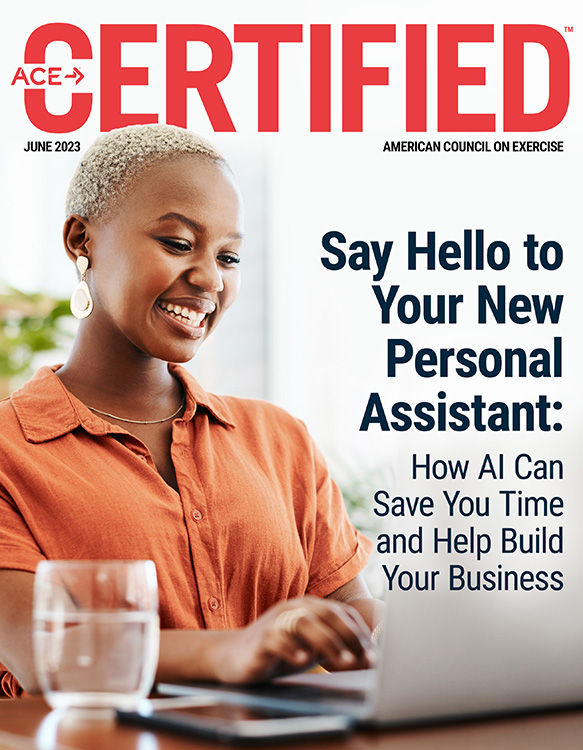
In March of 2020, just a few days after a state of emergency was declared in New York in response to the growing COVID-19 epidemic, Matt Sulam got a call from an older couple he’d been training for years.
“They were apologetic,” recalls Sulam, who lives in Commack on New York’s Long Island and has made a full-time living as a trainer since the late 1990s. “It was like, ‘I’m sorry, we can’t have you come to the house. We want to adhere to this shelter-in-place policy.’” Text after text followed from clients expressing similar sentiments. “It was an avalanche of cancellations,” Sulam said. “‘I thought to myself, ‘I have to shift on the fly.’”
Like many professional trainers during the depths of the pandemic, Sulam switched to online training—working with his clients one on one, first via Google Hangouts and now through WhatsApp. For him, the transition was surprisingly seamless. For his clients, the learning curve varied. “When I told my 17-year-old client we were going to be doing our sessions online, she was like ‘whatever,’” recalls Sulam with a chuckle.
Not so much with his clients in their 70s; for this clientele, Sulam had to do some cajoling and confidence-boosting. “I’m introducing a new training delivery system, but you may end up really enjoying it,” he recalls telling them. He also offered tutorials and help in getting set up. “With some of my older clients, we had to spend a little time with the basics,” he said. “‘This is where you stand so I can see you,’ ‘you need to put in your earphones,’ ‘here’s how you turn up the volume,’ that sort of stuff.”
A clear if not surprising difference in generational attitudes emerged: Younger clients tended to adapt quickly to the new technology. For some of the older ones, it took a little hand holding. But here’s the important thing: Almost all of them adapted to and, in many cases, flourished in the virtual training environment. “One of my clients in her 60s was reluctant and unsure at first,” Sulam recalls. “But after about a month, she was like, ‘This is fantastic!’”
Defining Generations
Generations are defined as groups of people born within the same 15- to 20-year span. These divided time periods can help us understand how our worldviews are shaped by the events that occur during our lifetimes. Here are the four dominant generations extant today and their birth years:
Baby Boomers: 1946–1964
Generation X: 1965–1980
Millennials: 1981–1996
Generation Z: 1997–2012
Harnessing the Power of Shared Experiences and Attitudes
While the last thing you want to do is to stereotype or overgeneralize about groups of people, it’s not unreasonable to consider that what might appeal to a twenty-something may not work for an older client. In fact, looking at the shared experiences and attitudes of different generations, says researcher Jane Buckingham, “can help show you how to motivate clients, [identify] what type of workouts they might gravitate to, or know what technology they are comfortable using to schedule training times or what their preferred method of payment might be.”
Buckingham is founder and CEO of Trendera, a Los Angeles-based consulting agency that specializes in generational research. “When we talk about generations we are talking about millions of people and not all will feel exactly the same way,” she says. “But by looking at what they have experienced as they grew up, it helps give context to some of their actions and needs.”
Buckingham offers this example: “Not every Millennial feels entitled and demands praise every second. But if they are looking for more reinforcement than a Gen X–aged trainer might normally think is appropriate to give their clients, then it might be good for the trainer to know that.”
As a health and exercise professional, you have likely seen this idea of generational theory played out in practice. “It makes perfect sense to me,” says Leigh Anne Bolling Richards, who teaches wellness and fitness classes at Auburn University-Montgomery and has had a long career in the fitness industry as a trainer, instructor and club manager. “I’ve dealt with members, clients, students, as well as staff of all ages,” she says. “And there are differences between a Baby Boomer and a Gen Z kid, a Gen Xer and a Millennial.”
Now an instructor in the Rock Steady Boxing program for individuals with Parkinson’s disease, Bolling Richards spends considerable time working with Boomers. But she’s the mother of a Millennial and former general manager of a popular gym in Montgomery, Ala., where she supervised staff members from across the generations. Her observations: “Baby Boomers tend to be pretty structured in what they want to do in their workouts,” she says. “This movement for that many reps, this long on the treadmill for that many minutes and at this intensity.” For Millennials, by contrast, “you’ve got to keep up the entertainment factor. By that, I mean, you’ve got to be ready to throw in new things. Millennials are like, ‘I’ve seen this workout on Instagram and I’d like to try this.’”
The members of Gen Z are even more connected to social media—and thus, bombarded with all kinds of fitness content, much of it dubious. “They see something on TikTok [and] I have to tell them, ‘That’s not how it works,’” says Bolling Richards. “And I think all of us as trainers need to do that. We don’t want to discourage their interest in different ways of working out, but I see the trainer’s job as educating [our clients] by telling them ‘Yes, we can do some of this hot new celebrity workout you saw, but if you really want to see results, this is what we have to do.’”
A Range of Motivations and Challenges
Recognizing that different generations have different motivations and challenges, depending on the phase of life they’re in, can help you design more effective and enjoyable workouts for your clients of various ages.
“Many Gen Z clients will want to be able to show what they are doing on social media and to their friends,” says Buckingham. “So consider a few ‘photo opps’ that you can build in during the course of the session.”
By contrast, while Boomers are less likely to post their workouts on social media, they are driven by a spirit of competitiveness. “Anti-aging, ‘turning back the clock,’ is important for them,” she adds. “They need clear markers of success and may want more recognition, not necessarily on social media, but in their gym or their community.”
Speaking of Boomers, University of Connecticut clinical psychologist Sherry Pagoto, PhD, reminds us that there are also physiological imperatives at play with this cohort, as well. “There’s the generational factor and there’s age,” says Dr. Pagoto. “They overlap. In the case of the Boomers, I think age matters a lot in terms of what kind of physical activities they’re going to be able to do and what comorbidities they might have. Heart disease, type 2 diabetes, osteoporosis, arthritis—all kinds of chronic diseases need to be taken into account. So some activities might be off the table for them, while others may be better suited.”
Beyond those commonsense precautions, Dr. Pagoto says that in some ways the Boomers are the ideal clients when it comes to making healthy behavioral changes in their lives. One advantage many Boomers have is that they have time, says Pagoto, who is the Director of the UConn Center for mHealth and Social Media. “You’ll see greater adherence from them. I love working with older adults because if you develop a plan, they’re more likely to follow through.”
For Gen-X moms, she notes, it’s a different challenge. “They are going to be tough from an adherence point of view. You have to do a lot of planning around life barriers.” Specifically, says Dr. Pagoto (herself a Gen Xer and a mom). “I think of the Gen Xers as the soccer mom generation. Given our age now, I think we’ve kind of lost ourselves in our kids. How do you get a Gen Xer to prioritize themself? In my work with weight management, I try to make them see that ‘me time’ isn’t selfish. You need it.”
At Great Jones Fitness, a one-on-one studio in lower Manhattan, the clients run the gamut from adolescents to near-octogenarians. While correctly pointing out that there are many individual exceptions across age ranges, co-owner Robert Morea says that “for the most part, it’s pretty consistent. My older population wants to be more functional. They want to be able to walk to the store or keep up their golf game. For the younger clients, it’s more about looking good.”
The age of the trainer also plays into this generational calculation. “If you’re an older trainer, you have to be open-minded to the perspectives and attitudes of your young clients,” says Morea, himself a Gen Xer. “Conversely, a young trainer shouldn’t dismiss the knowledge and experience of an older client.”
That, says Sulam, is the key to working across the generations. Along with looking at the differences that age and generational experience might make in fashioning a workout, he has learned—in the three years since he moved his business onto a virtual platform—that regardless of their age, everyone who walks into his virtual gym deserves to be treated with respect.
“I try to speak to every client professionally and respectfully,” Sulam says. “Whether you’re a 17-year-old or a 75-year-old.” Now that’s advice every generation can probably agree upon.

 by
by 


